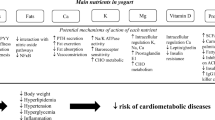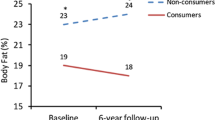Abstract
Purpose of the Review
Regular yogurt consumption has been associated with significant health benefits, including reducing weight gain and preventing obesity, prevention of diabetes, and improved overall diet quality. While yogurt has been aggressively marketed in recent years and consumption has increased, little is known about consumers of yogurt, including their health characteristics and nutrition attitudes and related behaviors. Our purpose was to summarize clinical studies on the health benefits of yogurt and also to report the results of an analysis of market research data on patterns and trends in consumption.
Recent Findings
A number of observational studies have reported associations of higher yogurt consumption with lower rates of obesity, weight gain, and diabetes. We analyzed detailed dietary intake surveys for 9560 adults and children. Women are more likely to be yogurt consumers than men (49.3 vs. 29.6%). Compared with non-consumers, consumers are more affluent and highly educated. 28.9% of yogurt consumers were obese, compared to 34.7% of non-consumers (p = 0.014). Consumers were more likely to be dieting at the time of the survey (22.9 vs. 17.7%, p = 0.02). There were substantial differences in nutrition attitudes, beliefs, and behaviors between consumers and non-consumers. Compared with non-consumers, yogurt consumers reported being more knowledgeable about nutrition (3.69 vs. 3.29, 5-point scale, p < 0.01) and also checking nutrition food labels (5.61 vs. 5.15, 7-point scale, p < 0.01). Consumers were less likely to agree than non-consumers that how a food tastes is more important than its nutritional value (4.08 vs. 4.45, 7-point scale, p < 0.01). Greek yogurt consumption increased from 1.8 mean annual eating occasions per capita in 2010 to 17.9 in 2015 (p < 0.01). Greek yogurt consumers were more likely than traditional yogurt consumers to live in households with annual incomes of $70,000 or more (45.6 vs. 33.2% for traditional yogurt consumers, p < .0.001).
Summary
Yogurt consumption has been associated with lower rates of obesity and better health in prior studies. Our new work suggests that these observations may be mediated by education, income, and more favorable attitudes toward highly nutritious foods.
Similar content being viewed by others
References
Papers of particular interest, published recently, have been highlighted as: • Of importance •• Of major importance
Global BMI Mortality Collaboration. Body-mass index and all-cause mortality: individual-participant-data meta-analysis of 239 prospective studies in four continents. Lancet. 2016;388(10046):776–86.
World Health Organization. http://www.who.int/nutrition/topics/nutrition_globaltargets2025/en/. Accessed 6 Feb 2017.
Moore LV, Thompson FE. Adults meeting fruit and vegetable intake recommendations—United States, 2013. MMWR. 2015;64(26):709–13.
Hoy MK, Goldman JD. Calcium intake of the US population. What we eat in America, NHANES 2009–2010. Food Surveys Research Group. Dietary data brief no. 13; 2014. Available from: https://www.ars.usda.gov/ARSUserFiles/80400530/pdf/DBrief/13_calcium_intake_0910.pdf.
Fisberg M, Machado R. History of yogurt and current patterns of consumption. Nutr Rev. 2015;73(Suppl 1):4–7.
Hess JM, Rao G, Slavin J. The nutrient density of snacks: a comparison of nutrient profiles of popular snack foods using the nutrient-rich foods index. Glob Ped Health. 2017;4:1–6.
The Nutrijournal. http://nutrijournal.danone.com/en/articles/stories/global-yogurt-consumption-per-capita-and-per-year/. Accessed 24 July 2017.
Dharmasena S, Okrent A, Capps O. Consumer demand for Greek-style yogurt and its implications to the dairy industry in the United States. Presented at Agricultural and Applied Economics Association’s 2014 AAEA Annual Meetings, Minneapolis, 2014. Available from: http://ageconsearch.umn.edu/bitstream/169799/2/Dharmasena_Okrent5-27-2014.pdf. Accessed 24 July 2017.
• Chen M, Sun Q, Giovanucci E, et al. Dairy consumption and risk of type 2 diabetes: 3 cohorts of US adults and an updated meta-analysis. BMC Med. 2014;12:215. https://doi.org/10.1186/s12916-014-0215-1. Yogurt consumption was consistently associated with a lower risk of diabetes among nearly four million person-years of follow-up.
Mozaffarian D, Hao T, Rimm EB, Willett WC, Hu FB. Changes in diet and lifestyle and long-term weight gain in women and men. N Engl J Med. 2011;364(25):2392–404.
Wang H, Livingston K, Fox C, Meigs J, Jacques P. Yogurt consumption is associated with better diet quality and metabolic profile in American men and women. Nutr Res. 2013;33:18–26.
•• Eales J, Lenoir-Wijnkoop I, King S, et al. Is consuming yogurt associated with weight management outcomes? Results from a systematic review. Int J Obesity. 2016;40:731–46. An extensive and methodologically sound systematic review which describes a positive association between yogurt and lower body mass index, less weight gain, smaller waist circumference, and lower body fat in cohort and cross-sectional studies, and to a lesser extent, in randomized trials.
• Panahi S, Fernandez MA, Marette A, Tremblay A. Yogurt, diet quality, and lifestyle factors. Eur J Clin Nutr. 2017;71:573–9. Yogurt consumers have a healthier lifestyle and more nutrition knowledge than non-consumers; findings are consistent with the analysis of market research data in our paper.
Keast DR, Hill Gallant KM, Albertson AM, Gugger CK, Holschuh NM. Associations between yogurt dairy, calcium, and vitamin D intake and obesity among US children aged 8–18 years: NHANES, 2005–2008. Nutrients. 2015;7:1577–93.
U.S. Department of Health and Human Services and U.S. Department of Agriculture. 2015–2020 dietary guidelines for Americans. 8th Ed. 2015. Available at http://health.gov/dietaryguidelines/2015/guidelines/. Accessed 24 July 2017.
Williams EB, Hooper B, Spiro A, Stanner S. The contribution of yogurt to nutrient intakes across the life course. Nutr Bull. 2015;40:9–32.
Zhu Y, Wang H, Hollis JH, Jacques PF. The associations between yogurt consumption, diet quality, and metabolic profiles in children in the USA. Eur J Nutr. 2015;54:543–50.
Cormier H, Thifault E, Garneau V, et al. Association between yogurt consumption, dietary patterns, and cardio-metabolic risk factors. Eur J Nutr. 2016;55:577–87.
Possa G, de Castro MA, Marchioni DM, Fisberg RM, Fisberg M. Probability and amounts of yogurt intake are differently affected by sociodemographic, economic, and lifestyle factors in adults and the elderly—results form a population-based study. Nutr Res. 2015;35:700–6.
D’addezio L, Mistura L, Sette S, Turrini A. Sociodemographic and lifestyle characteristics of yogurt consumers in Italy: results from the INRAN-SCAI 2005–06 survey. Med J Nutrition Metab. 2015;8:119–29.
Rao G, Kirley K, Weiss-Coleman R, et al. Consumption patterns of sugar-sweetened carbonated beverages among children and adolescents. Curr Cardiovasc Risk Rep. 2015;9:17. https://doi.org/10.1007/s12170-015-0445-6.
Centers for Disease Control and Prevention. National Health and Nutrition Examination Survey. https://wwwn.cdc.gov/nchs/nhanes/analyticguidelines.aspx. Accessed 7 Aug 2017.
Abrams IJ. Using the menu census survey to estimate dietary intake: postmarket surveillance of aspartame. In: Finley JW, Robinson SF, Armstrong DJ, editors. ACS Symposium Series no. 484: Food Safety Assessment. Washington, DC: American Chemical Society; 1992. p. 201–13.
NCCOR Catalogue of surveillance systems. https://tools.nccor.org/css/system/104/. Accessed 11 May 2017.
Guenther PM, Reedy J, Krebs-Smith SM. Development of the Healthy Eating Index-2005. J Am Diet Assoc. 2008;108(11):1896–901.
Rosenstock IM. The health belief model and preventive health behavior. Health Educ Behav. 1974;2(4):354–86.
Allen S, Goddard E. Consumer preferences for milk and yogurt attributes: how health beliefs and attitudes affect choices. http://ageconsearch.tind.io/record/125012/files/Allen.pdf. Accessed 7 May 2017.
Author information
Authors and Affiliations
Corresponding author
Ethics declarations
Conflict of Interest
Dr. Rao declares receiving grant from the Dannon Yogurt and serves on the Yogurt Advisory Board.
Dr. Bauer declares receiving a grant from the Dannon Yogurt.
Dr. Kuchta received a grant from Dannon Yogurt.
Dr. Inman declares no conflict of interests.
Dr. Solomonides received a grant from Dannon Yogurt.
Human and Animal Rights and Informed Consent
This article does not contain any studies with human or animal subjects performed by the authors.
Additional information
This article is part of the Topical Collection on Obesity and Diet
Rights and permissions
About this article
Cite this article
Rao, G., Bauer, V., Kuchta, K. et al. Yogurt, Its Relationship to Cardiometabolic Outcomes, and Patterns of Consumption. Curr Cardiovasc Risk Rep 11, 34 (2017). https://doi.org/10.1007/s12170-017-0561-6
Published:
DOI: https://doi.org/10.1007/s12170-017-0561-6




